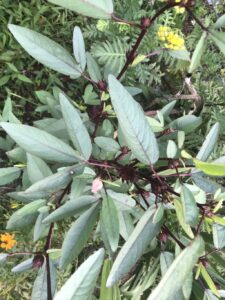- Like
- Digg
- Del
- Tumblr
- VKontakte
- Buffer
- Love This
- Odnoklassniki
- Meneame
- Blogger
- Amazon
- Yahoo Mail
- Gmail
- AOL
- Newsvine
- HackerNews
- Evernote
- MySpace
- Mail.ru
- Viadeo
- Line
- Comments
- Yummly
- SMS
- Viber
- Telegram
- Subscribe
- Skype
- Facebook Messenger
- Kakao
- LiveJournal
- Yammer
- Edgar
- Fintel
- Mix
- Instapaper
- Copy Link
A version of this column first ran in the Roane County (WV) Reporter and Times Record as part of a gardening series. Support local journalism! Subscribe to your local newspaper. This is one of a series of blogs for new gardeners. Start reading the whole series here: Part 1.
This week’s column is about experimentation, boldness, innovation, creativity…as pertains to the garden.
First of all, yeah—your garden doesn’t have to be a rectangle or square. That may be convenient if it’s plowed, but with a tiller, or permanent beds only turned with a shovel, you can work with any shape. You could make it shell-shaped, if that pleases you—or you could make it an irregular shape that fits the contour of the area you have for your garden—the area you have dibs on, that gets most of a day’s sun, and has decent soil. Curved sides may not work well with a fence, and you almost certainly need a fence unless you live in town and/or have an excellent dog dedicated to keeping the varmints out. But it doesn’t have to be four sides and they don’t have to be equal length.
Nor does your garden have to be one garden. If your land allows it, you might have more than one fenced space for growing plants. I have four: my well-fenced main garden with 24 permanent beds; a space I call Central which gets tilled and remains flat, which is better for corn and sorghum; North which is now six raised beds, higher than the ones in my main garden because North has drainage issues…and my flowerbed which is shaped like a capital D, a hemisphere. Having several gardens with at least a little distance between them has two advantages I see. It allows you to save seed from more than one variety of a vegetable in the same year (without them crossing), or from one variety while you grow several others in a distant bed. And it allows for better rotation of crops where disease is an issue, or certain bug problems. Many evil bugs lurk in the soil—or leave their eggs or larvae in the soil—all winter, to pounce on the crop next year. But they may not find it, and may just starve (I shed no tears) while your crop this year grows happily undisturbed a few hundred feet away. Fortunately, most pest bugs are picky eaters, and some are not much for travel.
Now here’s another thing. There is no law that says your vegetables have to be in a rectangle in your backyard and your flowers have to be in neat rows or curved beds in your front yard or surrounding your house. (Around here, anyway– I don’t know about some of those suburban places with Homeowners Associations that entitle themselves to make personal decisions for their members, which I consider un-West Virginian). Hey, it’s your house, and your garden space—if you want marigolds among your peppers or a clump of rainbow chard between your flowering shrubs, go right ahead. If flowers are important to you and you want to present a certain picture at the entrance to your house, you might want a separate cutting garden, perhaps among the vegetables, from which to fill the vases in your house while leaving the front flowerbeds uncut.
Along with these choices about how many gardens of what shape and size, try some boldness in your choices of what to grow. Grow what you and your family like to eat, if it’s at all feasible. I used to think we couldn’t grow sweet potatoes here, or peanuts, but I do fine with both. And if you had a garden in another location in the past, even if it’s not far from your current space, don’t assume your luck will run the same. I used to consider garlic and broccoli my most reliable crops, when my garden was in a bottom in Calhoun County. Here on a ridge in Roane, I have rot problems with garlic (I just have to grow a lot of it and harvest it promptly) and the broccoli and cabbage don’t want to make heads—so I grow bok choy instead. But I do well with melons—some years—and as I mentioned, sweet potatoes…
So, grow what you want, not what everyone else grows—even if it’s horseradish (yuck!) And keep trying new things, new vegetables or fruits or flowers, or new varieties of things you regularly raise. Experiment with different techniques, if you come across something that sounds interesting. That keeps it fun.
Read the rest: Part 1. Part 2. Part 3. Part 4. Part 5. Part 6. Part 7. Part 8. Part 9. Part 10. Part 11. Part 12. Part 13. Part 14. Part 15. Part 16. Part 17. Part 18. Part 19. Part 20. Part 21. Part 22. Part 23. Part 24. Part 25. Part 26. Part 27. Part 28. Part 29. Part 30. Part 31. Part 32. Part 33. Part 34. Part 35. Part 36. Part 37. Part 38. Part 39. Part 40. Part 41. Part 42. Part 43. Part 44. Part 45. Part 46. Part 47. Part 48. Part 49. Part 50. Part 51. Part 52.













